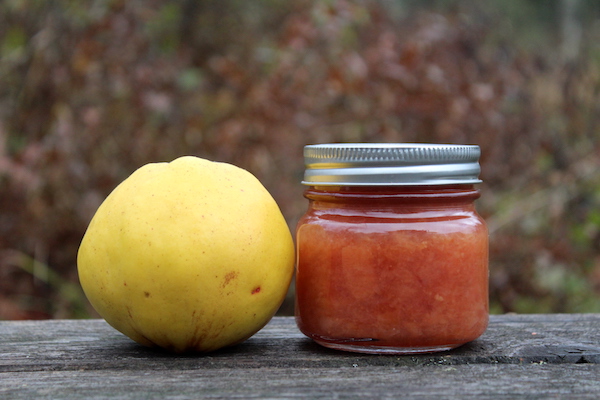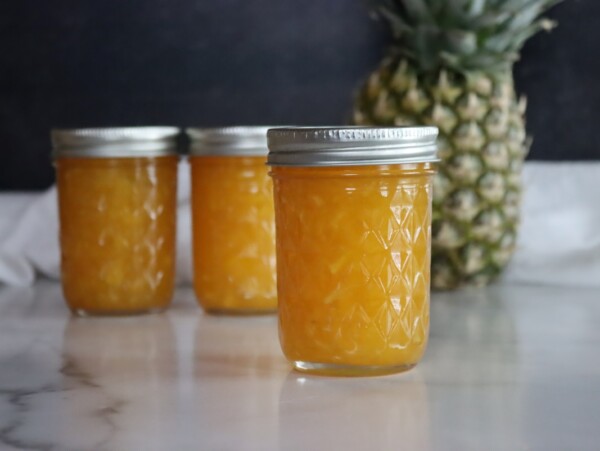Affiliate disclosure: This post may contain affiliate links. Please see our Privacy Policy.
Quince jam is my husband’s very favorite preserve, and until now I hadn’t ever even seen a quince. He grew up eating homemade quince jam from a backyard tree and dreams of one day having our own quince to harvest.
+We’ve planted a few trees, but they just can’t stand up to our cold winters. When I saw quince at our local store I knew I just had to make his very favorite quince jam, and now it’s our daughter’s favorite jam too!

If you’ve never worked with quince, you’re in for a bit of a surprise. Truly ripe fruit have an intoxicating aroma, but they’re hard as a rock. Choose quince that are firm and fragrant.
If you can’t smell them they’re not ripe yet, give them a week or so on the counter and they’ll have much more flavor.
Still, even fully ripe quince are not good for fresh eating. Try to bite into one and you’ll be sorry. They need cooking, lots of cooking before they’re fit for the table.

Use a sharp knife (and patient hand) to peel, core and chop quince like an apple. They’re so hard that it can be tricky to get the cores out, so be careful. Once you’ve prepared them in small chunks, put them in a saucepan with a bit of water and allow them to simmer on the stove until they start to fall apart.
Be patient, it’s going to take a while. They took longer than any jam I’ve ever made, and I was skeptical. At 30 minutes of simmering, they were still fully formed chunks and not even thinking about falling apart.
They were also still completely white, where cooked quince has a beautiful pink color. At 45 minutes of simmering, they abruptly turned pink and fell apart almost at once, so watch for it to happen suddenly…

Once they turn a beautiful rosy color and disintegrate, it’s time to add sugar and get jamming. Quince fruits have plenty of pectin on their own, so they’ll gel nicely into quinces preserves once they’re cooked with a bit of sugar. Add a little lemon juice to bring out the flavors of the fruit, and some warm spices like cardamom, cinnamon or allspice if you choose.
In just a few more minutes of cooking, the jam will come together and you’ll begin to see the spoon leaving trace marks as you stir. When it reaches a consistency that seems right to you, pour the quince jam into prepared canning jars, leaving 1/4 inch headspace. At this point, you can either store them in the refrigerator for immediate use or process the quince jam in a water bath canner for 5 minutes.

This recipe for quince jam is adapted from the Ball Complete Book of Home Preserving which has recipes for just about anything in the world you’d want to preserve.

Quince Jam Recipe for Canning
Ingredients
- 7 cups quince, peeled, cored and chopped
- 2-3 cups sugar
- 1/4 cup lemon juice
- Water
Instructions
- Peel, core and chop the quince as you would an apple. Simmer them in a bit of water until they turn a rosy color and fall apart (about 30 to 45 minutes). Add water as necessary to prevent the pan from running dry.
- Stir the quince to help break them up a bit, then add lemon juice and sugar. I like a low sugar recipe, with 2 cups of sugar. The "standard" recipe is 3 cups, so adjust to your own tastes.
- Cook the quince for another few minutes until the jam has thickened and begins to gel.
- Pour into prepared canning jars leaving 1/4 inch headspace and either store in the refrigerator for immediate use or process in a water bath canner for 5 minutes.
Nutrition
Nutrition information is automatically calculated, so should only be used as an approximation.
More Autumn Canning Recipes
Looking for more fall preserves? Try any of these:





My quince tree has not yet produced fruit, but I’m hoping that next year will be the year. I’ve read that the prepping of the fruit is the hardest part of dealing with quince; I’ve also read that pre-cooking the whole fruit makes the process much easier:
https://mycancalekitchen.com/cooking-quince-made-easy/
I hope this makes it easier for everyone!
Thank you for sharing.
:ast year I discovered an ornamental Japanese quince bush in the landscape of my new home. I did some research and waited until the fruit practically fell off the bush which was late October here in the Midwest US. I read that even though not grown for the fruit, you can still make jam. I have to let mine simmer almost an hour before it will turn color. It is quite sour but that’s what makes it oh so good. I just finished making a batch this year with your instructions. I too do a 5 min bath so I don’t have to refrigerate.
My cooking quince turned nice and soft but never turned that lovely pink. Wondering if it’s the variety of quince I used?
It’s definitely possible.
It took about an hour and a half before mine started to turn Pink. And then you need to boil for 20 minutes once the sugar is added. So it took about 2 hours of cooking and a half hour of prep. Then another half hour to complete canning.
This is a 3 hour project not 30 minutes.
As children, we used to eat the raw quince sprinkled with a bit of salt.
…and now I have a quince recipe. Thanks!
I don’t know how far north you are, but I’m in Berlin, and the quince grow really, really well. There are different types though, so maybe one is capable of doing well in your neck of the woods. I have a Turkish quince that produces large, pear shaped fruits that are much softer and sweeter. My neighbor has two different ‘German’ types that are pear shaped and apple shaped. They are all hard as rocks. My brain can’t understand why anyone would plant quince when pears are available!! I’m going to give quince jam a try though, and hopefully I will understand the attraction… Thanks for the tips!
You’re very welcome. So glad you enjoyed the post.
Can this recipe be doubled??
Sure can!
I never had a quince before, But plan to make up for lost time!!! This makes an AMAZING jam. Too cheap to throw the solids and seeds away, I macerated them with an equal amount of sugar and left them in the fridge a few days before simmering with enough cider and a few Tabs of lime juice to make a syrup. 1/2 pint (With 1 Tab corn starch) poured over Granny Smith apples in a pie crust made an excellent apple pie. I had enough to can 8 half pints for later.
Do you have to peel the quince? Can’t just core it and use a hand blender to chop it up a bit?
You are welcome to leave the skin on if you wish, just be sure to scrub them well to remove all of the fuzz.
I have made quince jelly from the fruit of my ornamental quince bushes. They are smaller, rock-hard, and take a long time to cook. I strained the pulp and made jelly from the juice. It got rave reviews. Problem is the harvest varies greatly from year to year.
Looks like that should be process for 15 minutes in water bath canner
The recommended canning time for full sugar jams/jellies from the national center for food preservation is only 5 minutes. I double-checked, and this includes quince preserves. I’ve also seen multiple recipes online using 10 minutes or 15 minutes as process times, but this is the process time I use. Use your best judgment, and those longer process times will not harm your jam. You’re welcome to use 10 or 15 minutes if you wish out of an abundance of caution.